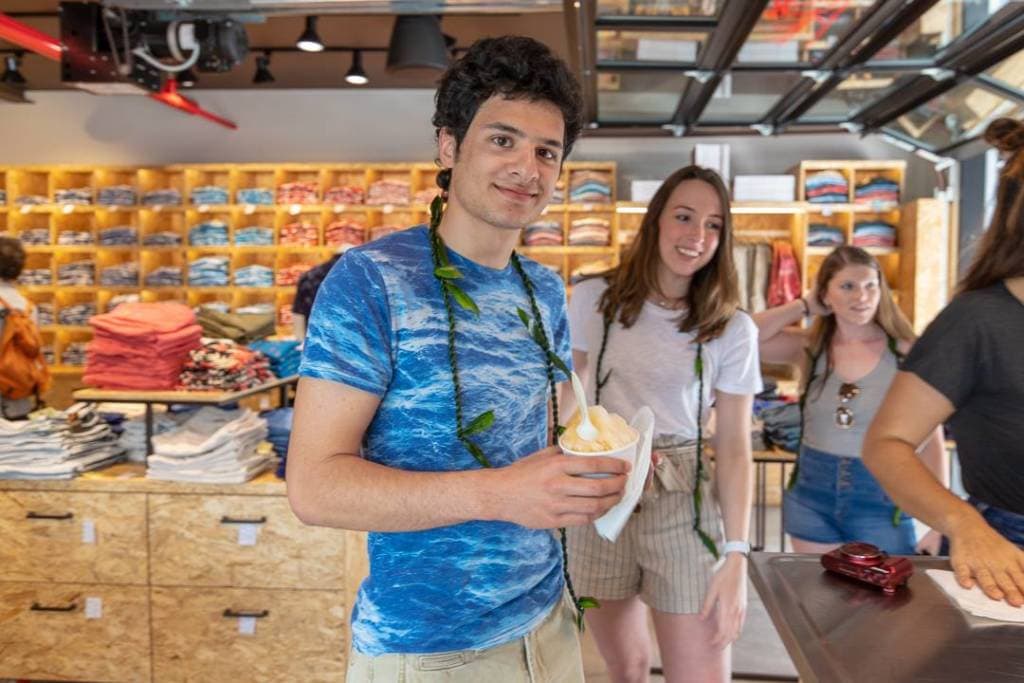Culinary tourism is a booming space within the travel industry, as students in Professor Christina Minihan‘s Culinary Tourism class are learning. But staying true to the roots of Hawaiian cuisine is imperative when telling the story of Hawaii’s culture and history, according to local food advocates who drive the culinary movement in Honolulu.
So how do restaurants and food purveyors on the island balance the desire to stay true to Hawaiian cuisine while also pleasing the millions of visitors that travel to Hawaii every year?
“My goal with this field class is for students to come away with an understanding of all the factors and decisions that go into a tourist culinary experience from the supply side decision makers, such as the ambiance, entertainment, or food quality,” said Dr. Minihan, who teaches at Colorado State University.
Agritourism guide and local agricultural activist Rachel LaDrig led Dr. Minihan’s class through a day of culinary visits while also educating students from the perspective of a local agritourism expert. “Food has always been integral to Hawaiian culture and there is an energy today about Hawaiians reclaiming their food,” LaDrig told students. “Food is a part of this place. How we experience a culture is quite literally through food. It is how you get to the root of most things.”

The first stop of the day was at local farm-to-table restaurant Moku Kitchen. Located in the newly trendy Kaka ‘Ako district, Moku Kitchen takes a modern, ingredient-focused approach to Hawaiian cuisine, sourcing produce from local farms as frequently as possible. General Manager Mason Hundhausen gave Semester at Sea students an introduction to the restaurant, as well as a tour of the kitchen to demonstrate their dedication to fresh ingredients.
“We are trying to get involved with as many local farmers as possible to create a hand-crafted experience for every one of our guests. It can be a challenge for a restaurant of our size to do that. Most restaurants of this size [in Hawaii] are doing corporate kitchens on the mainland and shipping the food to be reheated in the kitchen here, but that’s not what we’re all about. We’re trying to make as much in house as possible. I have bakers coming in at five am to make our pizza doughs and buns because every little thing really impacts the quality and taste of the food in the restaurant.”
Voyager Betty Hurd from the University of Arizona noted that the first field class of the voyage taught her “about the importance of the farm-to-table movement. I’m from Arizona where we don’t have much local produce but coming here, I thought it was fascinating to see how important local ingredients are to the cuisine, even in large kitchens like at the luau or Moku Kitchen.”

Next up on the culinary tour of Honolulu was Kahala, a local shave ice purveyor also located in the Kaka ‘Ako district. Shave ice is a famous Hawaiian dessert, popular with locals and tourists alike. It often features brightly dyed flavors, similar to a snow cone. Kahala distinguishes its shave ice by focusing on distinct, organic flavors derived from locally grown fruits, such as tamarind and lilikoi (passionfruit), paying homage to indigenous plants that have grown in Hawaii for thousands of years.
The final visit was to Paradise Cove Luau, located in Ko’Olina on the west side of O’ahu. Ernest, the manager of Beverage and Food Service, gave students a private tour of the luau grounds, including a demonstration of an imu oven, a traditional underground oven used for making kalua pork. “Each day, we have 700 or more guests, and one pig cannot serve all of them,” Ernest said. “We source nearly 500 pounds of pork daily, all of which we buy from Hawaiian pig farmers to maintain the integrity of the meat.”
After learning about the process of producing a luau every day, students had the pleasure of enjoying the food and entertainment of the Paradise Cove luau.
“Tasting the food was the most impactful part of the day for me. Seeing the process and how much time goes into how they produce the kalua pork was really incredible,” said Sara Shapiro from Colorado State University. “Getting to taste it afterward and see how juicy and tender it was made it that much more delicious.”




